Shot put
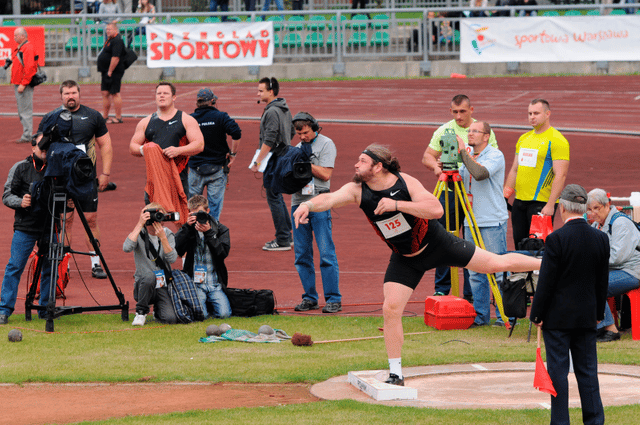
Shot put
The shot put (pronounced /ˈʃɒt pʊt/) is a track and field event involving "putting" (pushing rather than throwing) a heavy spherical object—the shot—as far as possible. The shot put competition for men has been a part of the modern Olympics since their revival in 1896, and women's competition began in 1948.
History
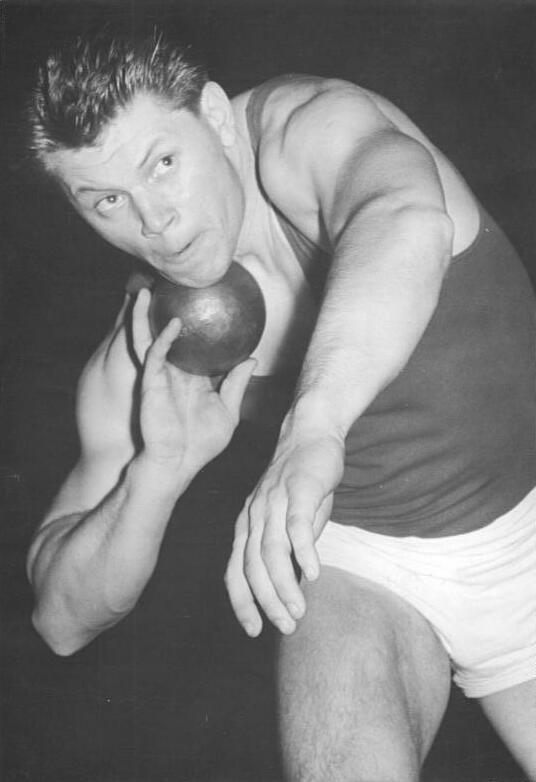
Czechoslovak shot putter Plíhal at the 1957 East German Indoor Athletics Championships
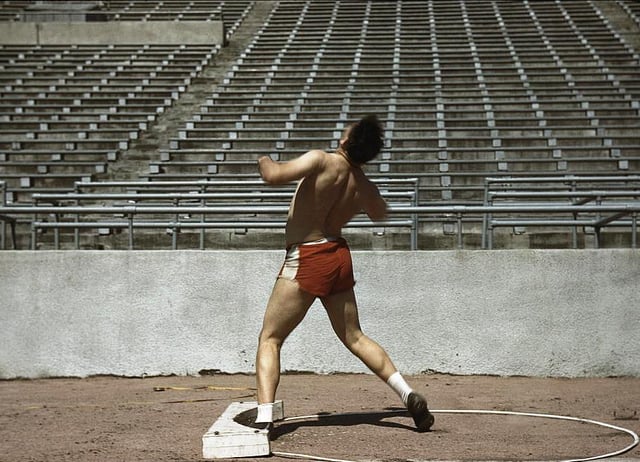
Shot putter at the University of Nebraska, 1942, showing the circle and stopboard
Homer mentions competitions of rock throwing by soldiers during the Siege of Troy but there is no record of any dead weights being thrown in Greek competitions. The first evidence for stone- or weight-throwing events were in the Scottish Highlands, and date back to approximately the first century.[1] In the 16th century King Henry VIII was noted for his prowess in court competitions of weight and hammer throwing.[2]
The first events resembling the modern shot put likely occurred in the Middle Ages when soldiers held competitions in which they hurled cannonballs. Shot put competitions were first recorded in early 19th century Scotland, and were a part of the British Amateur Championships beginning in 1866.[3]
Competitors take their throw from inside a marked circle 2.135m (7 ft) in diameter, with a stopboard about 10 centimetres (3.9 in) high at the front of the circle. The distance thrown is measured from the inside of the circumference of the circle to the nearest mark made on the ground by the falling shot, with distances rounded down to the nearest centimetre under IAAF and WMA rules.
Legal throws
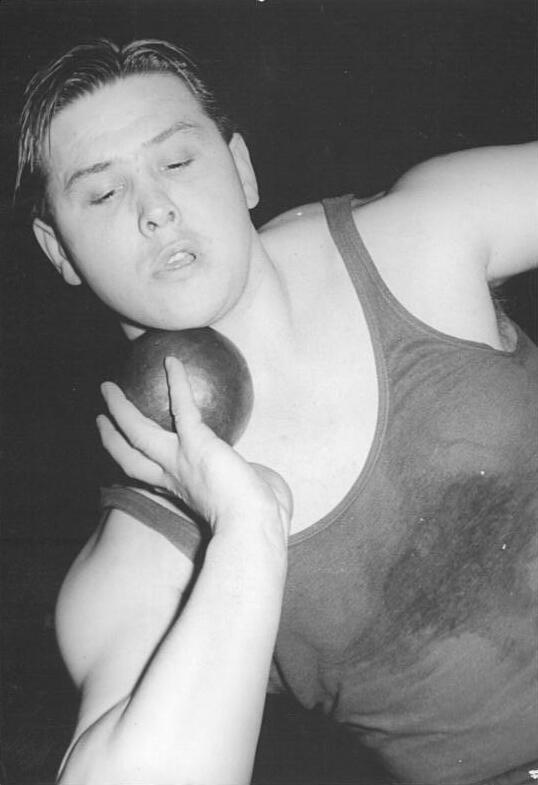
Czechoslovak shot putter Jiří Skobla showing the correct technique for keeping the shot near the neck
The following rules (indoor and outdoor) must be adhered to for a legal throw:
Upon calling the athlete's name, the athlete may choose any part of the throwing circle to enter inside. They have thirty seconds to commence the throwing motion; otherwise it counts as a forfeit for the current match.
The athlete may not wear gloves; IAAF rules permit the taping of individual fingers.
The athlete must rest the shot close to the neck, and keep it tight to the neck throughout the motion.
The shot must be released above the height of the shoulder, using only one hand.
The athlete may touch the inside surface of the circle or toe board, but must not touch the top or outside of the circle or toe board, or the ground beyond the circle. Limbs may, however, extend over the lines of the circle in the air.
The shot must land in the legal sector (34.92°) of the throwing area.
The athlete must leave the throwing circle from the back.
Foul throws occur when an athlete:
Does not pause within the circle before beginning the putting motion.
Does not complete the putting movement initiated within thirty seconds of having their name called.
Allows the shot to drop below his shoulder or outside the vertical plane of his shoulder during the put.
At any time if the shot loses contact with the neck then it is technically an illegal put.
During the putting motion, touches with any part of the body (including shoes): the top or ends of the toe board the top of the iron ring anywhere outside the circle.
Puts a shot which either falls outside the throwing sector or touches a sector line on the initial impact.
Leaves the circle before the shot has landed.
Does not leave from the rear half of the circle.
Regulation misconceptions
The following are either obsolete or non-existent, but commonly believed rules within professional competition:
The athlete must enter the circle from the back (none of the rule books contain such a clause).
The athlete entering the circle, then exiting and re-entering it prior to starting the throw results in a foul (all the rule books allow an athlete to leave a circle prior to starting a throw, but this still counts within the 30 second time limit; the allowable method of exiting the circle varies by rule book).
Loose clothing, shoelaces, or long hair touching outside the circle during a throw, or an athlete bringing a towel into the circle and then throwing it out prior to the put, results in a foul.
Competition
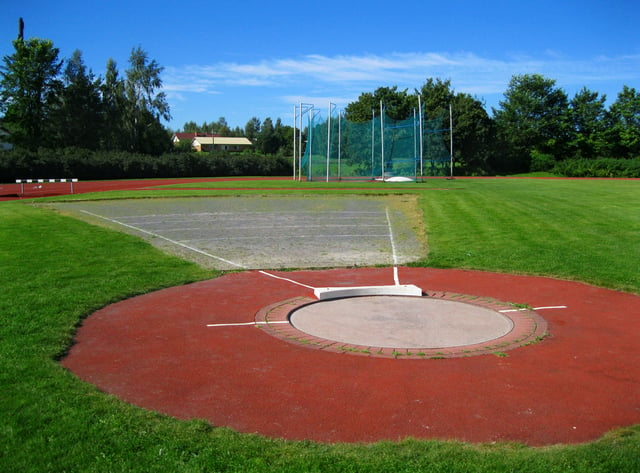
Shot put area
Shot put competitions have been held at the modern Summer Olympic Games since their inception in 1896, and it is also included as an event in the World Athletics Championships.
Each competition has a set number of rounds of throws. Typically there are three preliminary rounds to determine qualification for the final, and then three more rounds in the final. Each competitor is credited with their longest throw, regardless of whether it was achieved in the preliminary or final rounds. The competitor with the longest legal put is declared the winner.
Weight
In open competitions the men's shot weighs 7.260 kilograms (16.01 lb), and the women's shot weighs 4 kilograms (8.8 lb). Junior, school, and masters competitions often use different weights of shots, typically below the weights of those used in open competitions; the individual rules for each competition should be consulted in order to determine the correct weights to be used.
Putting styles
Two putting styles are in current general use by shot put competitors: the glide and the spin. With all putting styles, the goal is to release the shot with maximum forward velocity at an angle of approximately forty-five degrees.
Glide
The origin of this technique glide dates to 1951, when Parry O'Brien from the United States invented a technique that involved the putter facing backwards, rotating 180 degrees across the circle, and then tossing the shot. Unlike spin this technique is a linear movement.[4]
With this technique, a right-hand thrower would begin facing the rear of the circle. They would typically adopt a specific type of crouch, involving their bent right leg, in order to begin the throw from a more beneficial posture whilst also isometrically preloading their muscles. The positioning of their bodyweight over their bent leg, which pushes upwards with equal force, generates a preparatory isometric press. The force generated by this press will be channelled into the subsequent throw making it more powerful. To initiate the throw they kick to the front with the left leg, while pushing off forcefully with the right. As the thrower crosses the circle, the hips twist toward the front, the left arm is swung out then pulled back tight, followed by the shoulders, and they then strike in a putting motion with their right arm. The key is to move quickly across the circle with as little air under the feet as possible, hence the name 'glide'.
Spin
Also known as rotational technique.[5] It was first practiced in Europe in the 1950s but did not receive much attention until the 1970s.[6] In 1972 Aleksandr Baryshnikov set his first USSR record using a new putting style, the spin ("круговой мах" in Russian), invented by his coach Viktor Alexeyev.[7][8] The spin involves rotating like a discus thrower and using rotational momentum for power. In 1976 Baryshnikov went on to set a world record of 22.00 m (72.18 ft) with his spin style, and was the first shot putter to cross the 22-meter mark.[9]
With this technique, a right-hand thrower faces the rear, and begins to spin on the ball of the left foot. The thrower comes around and faces the front of the circle and drives the right foot into the center of the circle. Finally, the thrower reaches for the front of the circle with the left foot, twisting the hips and shoulders like in the glide, and puts the shot.
When the athlete executes the spin, the upper body is twisted hard to the right, so the imaginary lines created by the shoulders and hips are no longer parallel. This action builds up torque, and stretches the muscles, creating an involuntary elasticity in the muscles, providing extra power and momentum. When the athlete prepares to release, the left foot is firmly planted, causing the momentum and energy generated to be conserved, pushing the shot in an upward and outward direction.
Another purpose of the spin is to build up a high rotational speed, by swinging the right leg initially, then to bring all the limbs in tightly, similar to a figure skater bringing in their arms while spinning to increase their speed. Once this fast speed is achieved the shot is released, transferring the energy into the shot put.
Usage
Currently, most top male shot putters use the spin. However the glide remains popular since the technique leads to greater consistency compared to the rotational technique. Almost all throwers start by using the glide. Tomasz Majewski notes that although most athletes use the spin,[12] he and some other top shot putters achieved success using this classic method (for example he became first to defend the Olympic title in 56 years).
The world record by a male putter of 23.12 m (75 ft 10 in) by Randy Barnes was completed with the spin technique, while the second-best all-time put of 23.06 m (75 ft 7 3⁄4 in) by Ulf Timmermann was completed with the glide technique.
The decision to glide or spin may need to be decided on an individual basis, determined by the thrower's size and power. Short throwers may benefit from the spin and taller throwers may benefit from the glide, but many throwers do not follow this guideline.
Types of shots
The shot is made of different kinds of materials depending on its intended use. Materials used include sand, iron, cast iron, solid steel, stainless steel, brass, and synthetic materials like polyvinyl. Some metals are more dense than others making the size of the shot vary. For example, different materials are used to make indoor and outdoor shot - because damage to surroundings must be taken into account - so the latter are smaller. There are various size and weight standards for the implement that depend on the age and gender of the competitors as well as the national customs of the governing body.
World records
The current world record holders are:
| Type | Athlete | Distance | Venue | Date |
|---|---|---|---|---|
| Men | ||||
| Outdoor | Randy Barnes | 23.12 m (75 ft 10 in) | Los Angeles, California, USA | May 20, 1990 |
| Indoor | Randy Barnes | 22.66 m (74 ft 4 in) | Los Angeles, California, USA | January 20, 1989 |
| Women | ||||
| Outdoor | Natalya Lisovskaya | 22.63 m (74 ft23⁄4 in) | Moscow, USSR | June 7, 1987 |
| Indoor | Helena Fibingerová | 22.50 m (73 ft93⁄4 in) | Jablonec, CZE | February 19, 1977 |
Continental records
The current records held on each continent are:[13]
| Area | Men's | Women's | ||||
|---|---|---|---|---|---|---|
| Distance | Athlete | Nation | Distance | Athlete | Nation | |
| Africa | 21.97 m (72 ft3⁄4 in) | Janus Robberts | 18.43 m (60 ft51⁄2 in) | Vivian Chukwuemeka | ||
| Asia | 21.13 m (69 ft33⁄4 in) | Sultan Abdulmajeed Al-Hebshi | 21.76 m (71 ft41⁄2 in) | Meisu Li | ||
| Europe | 23.06 m (75 ft73⁄4 in) | Ulf Timmermann | 22.63 m (74 ft23⁄4 in) WR | Natalya Lisovskaya | ||
| North and Central America, and Caribbean | 23.12 m (75 ft 10 in) WR | Randy Barnes | 20.96 m (68 ft 9 in) A | Belsy Laza | ||
| Oceania | 22.67 m (74 ft41⁄2 in) | Tomas Walsh | 21.24 m (69 ft 8 in) | Valerie Adams | ||
| South America | 22.61 m (74 ft 2 in) | Darlan Romani | 19.30 m (63 ft33⁄4 in) A | Elisângela Adriano | ||
All-time top 25 shot putters
Men
| Rank | Mark | Technique | Athlete | Nationality | Date | Place | Ref |
|---|---|---|---|---|---|---|---|
| 1 | 23.12 m (75 ft 10 in) | spin | Randy Barnes | 20 May 1990 | Westwood | ||
| 2 | 23.06 m (75 ft73⁄4 in) | glide | Ulf Timmermann | 22 May 1988 | Khania | ||
| 3 | 22.91 m (75 ft13⁄4 in) | glide | Alessandro Andrei | 12 August 1987 | Viareggio | ||
| 4 | 22.86 m (75 ft 0 in) | spin | Brian Oldfield | 10 May 1975 | El Paso | ||
| 5 | 22.75 m (74 ft71⁄2 in) | glide | Werner Günthör | 23 August 1988 | Bern | ||
| 6 | 22.74 m (74 ft71⁄4 in) | spin | Ryan Crouser | 20 April 2019 | Long Beach | [16] | |
| 7 | 22.67 m (74 ft41⁄2 in) | spin | Kevin Toth | 19 April 2003 | Lawrence | ||
| spin | Tomas Walsh | 25 March 2018 | Auckland | [17] | |||
| 9 | 22.64 m (74 ft31⁄4 in) | glide | Udo Beyer | 20 August 1986 | Berlin | ||
| 10 | 22.61 m (74 ft 2 in) | spin | Darlan Romani | 30 June 2019 | Stanford | [18] | |
| 11 | 22.57 m (74 ft1⁄2 in) | spin | Joe Kovacs | 18 May 2017 | Tucson | [19] | |
| 12 | 22.54 m (73 ft111⁄4 in) | spin | Christian Cantwell | 5 June 2004 | Gresham | ||
| 13 | 22.52 m (73 ft101⁄2 in) | glide | John Brenner | 26 April 1987 | Walnut | ||
| 14 | 22.51 m (73 ft 10 in) | spin | Adam Nelson | 18 May 2002 | Gresham | ||
| 15 | 22.44 m (73 ft71⁄4 in) | spin | Darrell Hill | 31 August 2017 | Brussels | [20] | |
| 16 | 22.43 m (73 ft 7 in) | spin | Reese Hoffa | 3 August 2007 | London | ||
| 17 | 22.32 m (73 ft21⁄2 in) | spin | Michał Haratyk | 28 July 2019 | Warsaw | [21] | |
| 3 August 2019 | Władysławowo | [22] | |||||
| 18 | 22.28 m (73 ft 1 in) | spin | Ryan Whiting | 10 May 2013 | Doha | ||
| 19 | 22.25 m (72 ft113⁄4 in) | spin | Konrad Bukowiecki | 14 September 2019 | Chorzow | ||
| 20 | 22.24 m (72 ft111⁄2 in) | glide | Sergey Smirnov | 21 June 1986 | Tallinn | ||
| 21 | 22.22 m (72 ft103⁄4 in) | spin | Bob Bertemes | 4 August 2019 | Luxembourg City | ||
| 22 | 22.21 m (72 ft101⁄4 in) A | spin | Dylan Armstrong | 25 June 2011 | Calgary | ||
| 23 | 22.20 m (72 ft 10 in) | glide | David Storl | 9 July 2015 | Lausanne | [23] | |
| spin | John Godina | 22 May 2005 | Carson | ||||
| 25 | 22.17 m (72 ft83⁄4 in)i | spin | Tomáš Staněk | 6 February 2018 | Düsseldorf | [24] |
Notes
Below is a list of throws equal or superior to 22.43m:
Randy Barnes also threw 23.10 m (1990) 22.66 m i (1989)
Ryan Crouser also threw 22.73 m (2019), 22.67 m (2019), 22.65 m (2017), 22.62 m (2019), 22.53 m (2018), 22.52 m (2016), 22.47 m (2017), 22.44 m (2019), 22.43 m (2017).
Ulf Timmermann also threw 22.62 m (1985), 22.61 m (1988), 22.60 m (1986), 22.56 m (1988), 22.55 m (i) (1989), 22.51 m (1986), 22.47 m (1986, 1988).
Joe Kovacs also threw 22.56 m (2015).
Darlan Romani also threw 22.55 m (2019), 22.46 m (2019).
Tom Walsh also threw 22.60 m (2018), 22.45 m (2018), 22.44 m (2019).
Brian Oldfield also threw 22.45 m (A) (1976).
Christian Cantwell also threw 22.45 m (2006).
Werner Günthör also threw 22.47 m (1987), 22.43 m (1987).
Non-legal marks
Rolf Österreich of the East Germany threw a best of 22.11 on 12 September 1976 in Zschopau, but this mark was not recognized by East German authorities.
Andrei Mikhnevich of Belarus threw 22.10 on 8 August 2011 in Minsk. This mark was annulled due to doping offense.
Sergey Kasnauskas of Belarus threw 22.09 with an irregular implement on 23 August 1984 in Minsk.
Women
| Rank | Mark | Technique | Athlete | Nationality | Location | Date |
|---|---|---|---|---|---|---|
| 1 | 22.63 m (74 ft23⁄4 in) | glide | Natalya Lisovskaya | Moscow | June 7, 1987 | |
| 2 | 22.50 m (73 ft93⁄4 in)i | glide | Helena Fibingerová | Jablonec nad Nisou | February 19, 1977 | |
| 3 | 22.45 m (73 ft73⁄4 in) | glide | Ilona Slupianek | Potsdam | May 11, 1980 | |
| 4 | 22.19 m (72 ft91⁄2 in) | glide | Claudia Losch | Hainfeld | August 23, 1987 | |
| 5 | 21.89 m (71 ft93⁄4 in) | glide | Ivanka Khristova | Belmeken | July 4, 1976 | |
| 6 | 21.86 m (71 ft81⁄2 in) | glide | Marianne Adam | Leipzig | June 23, 1979 | |
| 7 | 21.76 m (71 ft41⁄2 in) | glide | Li Meisu | Shijiazhuang | April 23, 1988 | |
| 8 | 21.73 m (71 ft31⁄2 in) | glide | Natalya Akhrimenko | Leselidze | May 21, 1988 | |
| 9 | 21.69 m (71 ft13⁄4 in) | glide | Vita Pavlysh | Budapest | August 15, 1998 | |
| 10 | 21.66 m (71 ft3⁄4 in) | glide | Sui Xinmei | Beijing | June 9, 1990 | |
| 11 | 21.62 m (70 ft 11 in) | glide | Verzhinia Veselinova | Sofia | August 21, 1982 | |
| 12 | 21.60 m (70 ft101⁄4 in)i | glide | Valentina Fedyushina | Simferopol | December 28, 1991 | |
| 13 | 21.58 m (70 ft91⁄2 in) | glide | Margitta Pufe | Erfurt | May 28, 1978 | |
| 14 | 21.57 m (70 ft 9 in) | glide | Ines Müller | Athens | May 16, 1988 | |
| 15 | 21.53 m (70 ft71⁄2 in) | glide | Nunu Abashidze | Kiev | June 20, 1984 | |
| 16 | 21.52 m (70 ft 7 in) | glide | Huang Zhihong | Beijing | June 27, 1990 | |
| 17 | 21.46 m (70 ft43⁄4 in) | glide | Larisa Peleshenko | Budapest | August 26, 2000 | |
| 18 | 21.45 m (70 ft41⁄4 in) | glide | Nadezhda Chizhova | Varna | September 29, 1973 | |
| 19 | 21.43 m (70 ft31⁄2 in) | glide | Eva Wilms | Munich | June 27, 1977 | |
| 20 | 21.42 m (70 ft31⁄4 in) | glide | Svetlana Krachevskaya | Moscow | July 24, 1980 | |
| 21 | 21.31 m (69 ft103⁄4 in) | glide | Heike Hartwig | Athens | May 16, 1988 | |
| 22 | 21.27 m (69 ft91⁄4 in) | glide | Liane Schmuhl | Cottbus | June 26, 1982 | |
| 23 | 21.24 m (69 ft 8 in) | glide | Valerie Adams | Daegu | August 29, 2011 | |
| 24 | 21.22 m (69 ft71⁄4 in) | glide | Astrid Kumbernuss | Gothenburg | August 5, 1995 | |
| 25 | 21.21 m (69 ft 7 in) | glide | Kathrin Neimke | Rome | September 5, 1987 |
Notes
Best women's throw using a spin technique is 19.87m by Anita Márton and Jillian Camarena-Williams.
Below is a list of throws equal or superior to 21.49m:
Natalya Lisovskaya also threw 22.14m i (1987), 21.60m (1988).
Helena Fibingerová also threw 21.75m i (1977), 21.66m (1977), 21.58m i (1977), 21.47m i (1985), 21.46m i (1977).
Ilona Slupianek also threw 21.59m i (1979), 21.52m i (1980), 21.49m i (1980).
Annulled
The following athletes had their performance (inside 21.49 annulled due to doping offenses:
Nadzeya Ostapchuk 21.70 m (i) (Mogilev 2010)
Olympic medalists
Men
| Games | Gold | Silver | Bronze |
|---|---|---|---|
| 1896 Athens | Robert Garrett | Miltiadis Gouskos | Georgios Papasideris |
| 1900 Paris | Richard Sheldon | Josiah McCracken | Robert Garrett |
| 1904 St. Louis | Ralph Rose | Wesley Coe | Lawrence Feuerbach |
| 1908 London | Ralph Rose | Denis Horgan | John Garrels |
| 1912 Stockholm | Pat McDonald | Ralph Rose | Lawrence Whitney |
| 1920 Antwerp | Ville Pörhölä | Elmer Niklander | Harry Liversedge |
| 1924 Paris | Bud Houser | Glenn Hartranft | Ralph Hills |
| 1928 Amsterdam | John Kuck | Herman Brix | Emil Hirschfeld |
| 1932 Los Angeles | Leo Sexton | Harlow Rothert | František Douda |
| 1936 Berlin | Hans Woellke | Sulo Bärlund | Gerhard Stöck |
| 1948 London | Wilbur Thompson | Jim Delaney | Jim Fuchs |
| 1952 Helsinki | Parry O'Brien | Darrow Hooper | Jim Fuchs |
| 1956 Melbourne | Parry O'Brien | Bill Nieder | Jiří Skobla |
| 1960 Rome | Bill Nieder | Parry O'Brien | Dallas Long |
| 1964 Tokyo | Dallas Long | Randy Matson | Vilmos Varjú |
| 1968 Mexico City | Randy Matson | George Woods | Eduard Gushchin |
| 1972 Munich | Władysław Komar | George Woods | Hartmut Briesenick |
| 1976 Montreal | Udo Beyer | Yevgeniy Mironov | Aleksandr Baryshnikov |
| 1980 Moscow | Vladimir Kiselyov | Aleksandr Baryshnikov | Udo Beyer |
| 1984 Los Angeles | Alessandro Andrei | Mike Carter | Dave Laut |
| 1988 Seoul | Ulf Timmermann | Randy Barnes | Werner Günthör |
| 1992 Barcelona | Mike Stulce | Jim Doehring | Vyacheslav Lykho |
| 1996 Atlanta | Randy Barnes | John Godina | Oleksandr Bagach |
| 2000 Sydney | Arsi Harju | Adam Nelson | John Godina |
| 2004 Athens | Adam Nelson | Joachim Olsen | Manuel Martínez |
| 2008 Beijing | Tomasz Majewski | Christian Cantwell | Dylan Armstrong |
| 2012 London | Tomasz Majewski | David Storl | Reese Hoffa |
| 2016 Rio de Janeiro | Ryan Crouser | Joe Kovacs | Tomas Walsh |
Women
| Games | Gold | Silver | Bronze |
|---|---|---|---|
| 1948 London | Micheline Ostermeyer | Amelia Piccinini | Ina Schäffer |
| 1952 Helsinki | Galina Zybina | Marianne Werner | Klavdiya Tochenova |
| 1956 Melbourne | Tamara Tyshkevich | Galina Zybina | Marianne Werner |
| 1960 Rome | Tamara Press | Johanna Lüttge | Earlene Brown |
| 1964 Tokyo | Tamara Press | Renate Culmberger | Galina Zybina |
| 1968 Mexico City | Margitta Gummel | Marita Lange | Nadezhda Chizhova |
| 1972 Munich | Nadezhda Chizhova | Margitta Gummel | Ivanka Khristova |
| 1976 Montreal | Ivanka Khristova | Nadezhda Chizhova | Helena Fibingerová |
| 1980 Moscow | Ilona Slupianek | Svetlana Krachevskaya | Margitta Pufe |
| 1984 Los Angeles | Claudia Losch | Mihaela Loghin | Gael Martin |
| 1988 Seoul | Natalya Lisovskaya | Kathrin Neimke | Li Meisu |
| 1992 Barcelona | Svetlana Krivelyova | Huang Zhihong | Kathrin Neimke |
| 1996 Atlanta | Astrid Kumbernuss | Sui Xinmei | Irina Khudoroshkina |
| 2000 Sydney | Yanina Karolchik | Larisa Peleshenko | Astrid Kumbernuss |
| 2004 Athens | Yumileidi Cumbá | Nadine Kleinert | Not awarded[25] |
| 2008 Beijing | Valerie Vili | Misleydis González | Gong Lijiao |
| 2012 London | Valerie Adams | Gong Lijiao | Li Ling |
| 2016 Rio de Janeiro | Michelle Carter | Valerie Adams | Anita Márton |
World Championship medalists
Men
| Championships | Gold | Silver | Bronze |
|---|---|---|---|
| 1983 Helsinki | |||
| 1987 Rome | |||
| 1991 Tokyo | |||
| 1993 Stuttgart | |||
| 1995 Gothenburg | |||
| 1997 Athens | |||
| 1999 Seville | |||
| 2001 Edmonton | |||
| 2003 Saint-Denis | |||
| 2005 Helsinki | |||
| 2007 Osaka | |||
| 2009 Berlin | |||
| 2011 Daegu | |||
| 2013 Moscow | |||
| 2015 Beijing | |||
| 2017 London |
Women
| Championships | Gold | Silver | Bronze |
|---|---|---|---|
| 1983 Helsinki | |||
| 1987 Rome | |||
| 1991 Tokyo | |||
| 1993 Stuttgart | |||
| 1995 Gothenburg | |||
| 1997 Athens | |||
| 1999 Seville | |||
| 2001 Edmonton | |||
| 2003 Saint-Denis | |||
| 2005 Helsinki[26] | |||
| 2007 Osaka | |||
| 2009 Berlin | |||
| 2011 Daegu | |||
| 2013 Moscow | |||
| 2015 Beijing | |||
| 2017 London |
World Indoor Championships medalists
Men
| Games | Gold | Silver | Bronze |
|---|---|---|---|
| 1985 Paris[A] | |||
| 1987 Indianapolis | |||
| 1989 Budapest | |||
| 1991 Seville | |||
| 1993 Toronto | |||
| 1995 Barcelona | |||
| 1997 Paris | |||
| 1999 Maebashi | |||
| 2001 Lisbon | |||
| 2003 Birmingham | |||
| 2004 Budapest | |||
| 2006 Moscow | |||
| 2008 Valencia | |||
| 2010 Doha | |||
| 2012 Istanbul | |||
| 2014 Sopot | |||
| 2016 Portland | |||
| 2018 Birmingham |
Women
| Games | Gold | Silver | Bronze |
|---|---|---|---|
| 1985 Paris[A] | |||
| 1987 Indianapolis | |||
| 1989 Budapest | |||
| 1991 Seville | |||
| 1993 Toronto | |||
| 1995 Barcelona | |||
| 1997 Paris | |||
| 1999 Maebashi | |||
| 2001 Lisbon | |||
| 2003 Birmingham | |||
| 2004 Budapest | |||
| 2006 Moscow | |||
| 2008 Valencia | |||
| 2010 Doha | |||
| 2012 Istanbul | |||
| 2014 Sopot | |||
| 2016 Portland | |||
| 2018 Birmingham |
A Known as the World Indoor Games
Season's bests
See also
Masters shot put
Pundo
Stone put
20 metre club